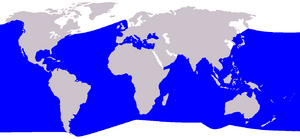Cuvier's beaked whale facts for kids
Quick facts for kids Cuvier's beaked whaleTemporal range: Pliocene-recent
|
|
|---|---|
 |
|
 |
|
| Size compared to an average human | |
| Conservation status | |
| Scientific classification | |
| Genus: |
Ziphius
|
| Species: |
cavirostris
|
 |
|
| Range of Cuvier's beaked whale | |
The Cuvier's beaked whale (Ziphius cavirostris) is a special kind of whale. It is the only member of its group, called Ziphius. You can find this whale in more places than any other beaked whale.
These whales are amazing divers. They can dive deeper than almost any other sea animal. They can go nearly 3 kilometers (about 2 miles) down. They can also hold their breath for more than two hours!
How We Found Out About Them
A French scientist named Georges Cuvier first described this whale. He did this in 1823. He studied an old skull found on the coast of France. A farmer found it in 1803.
Cuvier named the whale Ziphius cavirostris. The name cavirostris comes from a Latin word meaning "hollow". This is because the whale's skull has a deep hollow. This hollow is a special feature that helps identify the species. At first, Cuvier thought this whale was extinct, meaning it no longer lived on Earth.
But in 1850, scientists learned the whale was still alive. Another scientist, Paul Gervais, compared Cuvier's skull to a whale found on a beach. He saw they were the same.
What They Eat and How They Dive
Cuvier's beaked whales love to eat squid. They also hunt for fish that live deep in the ocean. On March 27, 2014, a Cuvier's beaked whale set a new diving record. It dove almost two miles (about 3.2 kilometers) deep! This was the deepest dive ever recorded for a sea mammal.
Even though they are a type of toothed whale (called Odontoceti), they don't use their teeth much for eating. Adult whales have two small teeth that stick out from their lower jaw. Instead of chewing, they suck in their food. They do this by making their throat bigger, like a vacuum cleaner!
Images for kids
-
Cuvier's beaked whale surfaces in the Ligurian Sea
-
Cuvier's beaked whale surfaces in the Ligurian Sea
See also
 In Spanish: Zifio o ballenato de Cuvier para niños
In Spanish: Zifio o ballenato de Cuvier para niños






